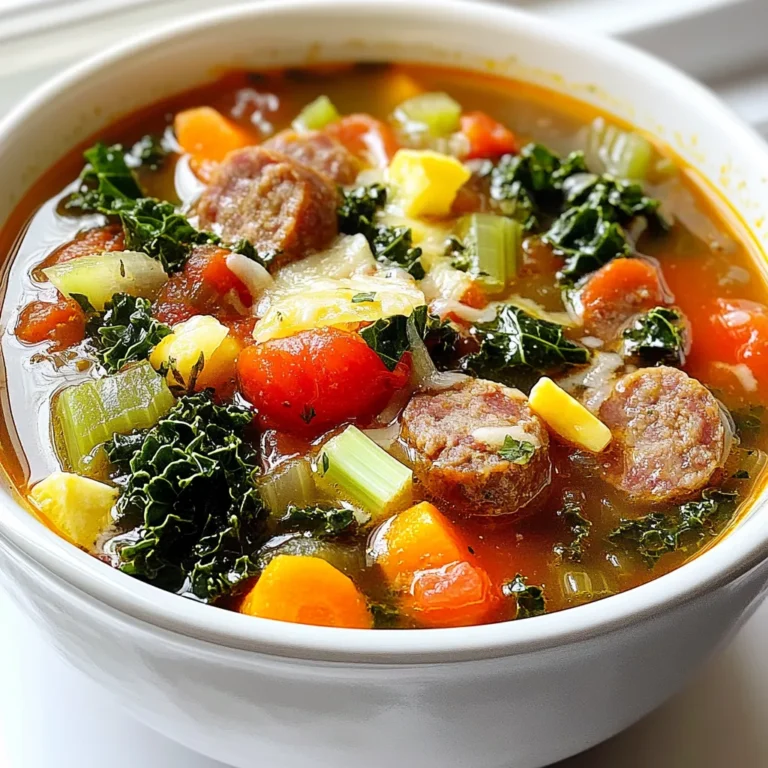Creamy Garlic White Bean Stew Hearty Dinner Delight

Are you ready for a warm and filling meal? This Creamy Garlic White Bean Stew is your answer! Packed with rich flavor and nutrients, it’s perfect for any dinner table. In this post, I’ll guide you through each step, from simple ingredients to cooking tips. Whether you’re a busy parent or a novice cook, you’ll whip up this hearty delight in no time. Let’s get started!
Why I Love This Recipe
- Comforting and Creamy: This stew is the perfect blend of creamy coconut milk and hearty white beans, making it an ideal comfort food for chilly evenings.
- Nutritious Ingredients: Packed with vegetables and beans, this recipe is not only delicious but also loaded with nutrients that support a healthy diet.
- Quick and Easy: With just 10 minutes of prep and 40 minutes total cooking time, it’s a simple recipe that fits perfectly into a busy schedule.
- Versatile and Adaptable: You can easily customize this stew by adding your favorite vegetables or spices, making it a flexible dish for any palate.
Ingredients
List of Ingredients
- 2 cans (15 oz each) white beans (cannellini or great northern), drained and rinsed
- 4 cups vegetable broth
- 1 medium onion, finely chopped
- 4 cloves garlic, minced
- 2 medium carrots, diced
- 2 celery stalks, diced
- 1 cup kale, roughly chopped
- 1 cup coconut milk (preferably full-fat for extra creaminess)
- 2 tablespoons olive oil
- 1 teaspoon dried thyme
- 1 teaspoon smoked paprika
- Salt and freshly ground black pepper to taste
- Fresh parsley, finely chopped (for garnish)
Optional Additions
You can make your stew even better! Try adding:
- A squeeze of lemon juice for brightness
- Chopped spinach for extra greens
- Sliced mushrooms for a meaty texture
- A pinch of red pepper flakes for spice
Health Benefits of Key Ingredients
This stew is not just tasty; it’s healthy too! Here’s how:
- White Beans: They are full of protein and fiber. They help keep you full.
- Kale: This leafy green is rich in vitamins A, C, and K. It supports your immune system.
- Olive Oil: A heart-healthy fat that adds flavor. It’s good for your heart.
- Garlic: Known for its immune-boosting properties. It has many health benefits.
- Coconut Milk: Provides healthy fats and a creamy texture. It helps make the stew rich and satisfying.
This creamy garlic white bean stew is not just a meal; it’s a warm hug in a bowl! Enjoy the flavors and the health benefits in every spoonful.

Step-by-Step Instructions
Sautéing the Vegetables
Start by heating the olive oil in a large pot over medium heat. You want the oil to shimmer. Once it’s ready, add the finely chopped onion, diced carrots, and diced celery. Sauté these veggies for about 5 to 6 minutes. You want the onions to turn translucent and the veggies to soften. This step builds a great base for your stew.
Adding Garlic and Spices
Next, stir in the minced garlic. Cook it for 1 to 2 minutes. Keep stirring so the garlic becomes fragrant but does not burn. After that, add the drained white beans, vegetable broth, dried thyme, and smoked paprika to the pot. Stir everything well to mix. This is where the magic begins!
Simmering the Stew
Now, bring the mixture to a gentle simmer. Reduce the heat to low and let it simmer for about 15 to 20 minutes. This time allows the flavors to blend nicely. After the simmering, add the chopped kale and pour in the coconut milk. Simmer for another 5 to 10 minutes until the kale wilts and the stew becomes creamy. Adjust the taste with salt and black pepper before serving.
Tips & Tricks
Best Practices for Creaminess
To achieve the perfect creamy texture in your stew, always use full-fat coconut milk. This adds richness and smoothness. You can blend part of the white beans for an even creamier base. Just reserve a cup of beans, blend them with some broth, and stir them back in. This makes the stew thick and luscious.
Enhancing the Flavor
To boost the flavor, add fresh herbs like thyme or rosemary. Fresh herbs can brighten up the dish. A squeeze of lemon juice right before serving adds a tasty zing. Always taste as you cook, adjusting salt and pepper for your perfect balance. Smoked paprika adds a lovely depth. You can even try a splash of soy sauce for an umami kick.
Cooking Variations for Different Diets
For vegan or gluten-free diets, this stew is already a great choice. If you want more protein, add tofu or tempeh. For a heartier meal, serve it over brown rice or quinoa. If you like spice, add red pepper flakes or diced jalapeños. These options let you customize the stew to fit your needs while keeping it delicious and satisfying.
Pro Tips
- Perfect Bean Choice: Use a mix of cannellini and great northern beans for a more complex texture and flavor in your stew.
- Enhance the Creaminess: For an extra creamy texture, blend a portion of the beans with the coconut milk before adding it to the stew.
- Season Gradually: Taste and adjust seasoning throughout the cooking process to ensure the flavors develop harmoniously.
- Add a Kick: If you like heat, consider adding a pinch of red pepper flakes or a dash of hot sauce to the stew for an extra layer of flavor.

Variations
Vegetarian and Vegan Options
This creamy garlic white bean stew is already vegetarian. To make it vegan, just use vegetable broth and coconut milk, which it already calls for. You can add more veggies like bell peppers or zucchini. They will add flavor and color. If you want to add some herbs, try fresh basil or oregano for a fresh twist.
Adding Protein Sources
If you want more protein, consider adding cooked quinoa or lentils. Both options blend well with the stew and keep it hearty. You can also add tofu for a protein boost. Just make sure to sauté the tofu until it’s golden. This will give it a nice texture and flavor.
Spice Level Adjustments
If you love heat, kick up the spice! Add crushed red pepper flakes or diced jalapeños. Start with a small amount and taste as you go. This way, you can control the heat. For a smoky flavor, a bit more smoked paprika works great. You can even add a splash of hot sauce at the end if you want an extra kick.
Storage Info
Refrigerating Leftovers
After enjoying your creamy garlic white bean stew, let it cool. Place the stew in an airtight container. It keeps well in the fridge for up to four days. This makes it easy to have a quick meal later. When you want to eat it, just take it out and enjoy!
Freezing the Stew
If you want to save the stew for later, freezing is a great option. Pour the cooled stew into freezer-safe bags or containers. Leave some space at the top for expansion. It can last in the freezer for up to three months. When you’re ready for a warm meal, just thaw it in the fridge overnight.
Reheating Instructions
To reheat, you can use the stove or microwave. For the stove, pour the stew into a pot. Heat on low, stirring often until it’s hot. If you’re using a microwave, place the stew in a microwave-safe bowl. Heat on high for 1-2 minutes. Stir halfway to ensure even heating. Enjoy it hot and fresh, just like the first time!
FAQs
Can I use dried beans instead of canned?
Yes, you can use dried beans. Start by soaking them overnight. After soaking, cook them until soft. This may take about 1-2 hours. Once cooked, drain and rinse before using. You will need about 1.5 cups of cooked beans for this stew.
What can I serve with Creamy Garlic White Bean Stew?
This stew pairs well with many dishes. You can serve it with crusty bread for dipping. A fresh salad adds a nice crunch. Rice or quinoa can also make it a more filling meal. If you want a side, roasted veggies work great too.
How to make the stew spicier?
To spice up your stew, add a pinch of cayenne pepper. You can also use red pepper flakes for heat. If you like fresh flavors, try adding chopped jalapeños. Just remember to start small. You can always add more spice as it cooks.
This blog post covered how to make a creamy garlic white bean stew. We explored the key ingredients and their health benefits. I shared step-by-step instructions, tips for creaminess, and ways to add flavor. You learned about variations for different diets and how to store leftovers.
In closing, this stew is easy and delicious. You can adjust it to fit your taste and needs. Enjoy making it your ow
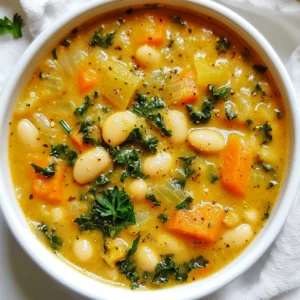
Creamy Garlic White Bean Stew
Ingredients
- 2 cans white beans (such as cannellini or great northern), drained and rinsed
- 4 cups vegetable broth
- 1 medium onion, finely chopped
- 4 cloves garlic, minced
- 2 medium carrots, diced
- 2 stalks celery, diced
- 1 cup kale, roughly chopped
- 1 cup coconut milk (preferably full-fat)
- 2 tablespoons olive oil
- 1 teaspoon dried thyme
- 1 teaspoon smoked paprika
- to taste salt and freshly ground black pepper
- for garnish fresh parsley, finely chopped
Instructions
- In a large pot, heat the olive oil over medium heat. Once the oil is shimmering, add the finely chopped onion, diced carrots, and diced celery. Sauté the mixture for about 5-6 minutes or until the onions become translucent and the vegetables begin to soften.
- Stir in the minced garlic and continue to cook for an additional 1-2 minutes, stirring frequently, until the garlic is fragrant but not burnt.
- Add the drained white beans, vegetable broth, dried thyme, and smoked paprika to the pot. Stir well to combine all the ingredients and bring the mixture to a gentle simmer.
- Reduce the heat to low, allowing the stew to simmer for 15-20 minutes. This will enable the flavors to meld beautifully.
- After the simmering time, stir in the chopped kale and pour in the coconut milk. Let it simmer for an additional 5-10 minutes, stirring occasionally, until the kale is wilted and the stew reaches a creamy consistency.
- Adjust the flavor by seasoning with salt and freshly ground black pepper to taste.
- Serve the stew hot, garnished with a sprinkle of freshly chopped parsley for a pop of color and freshness.


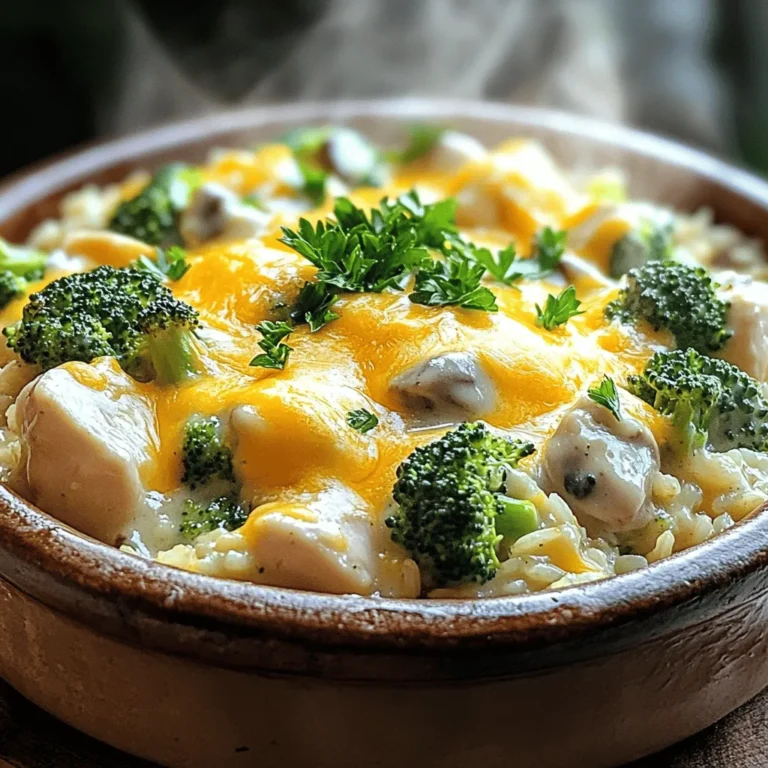
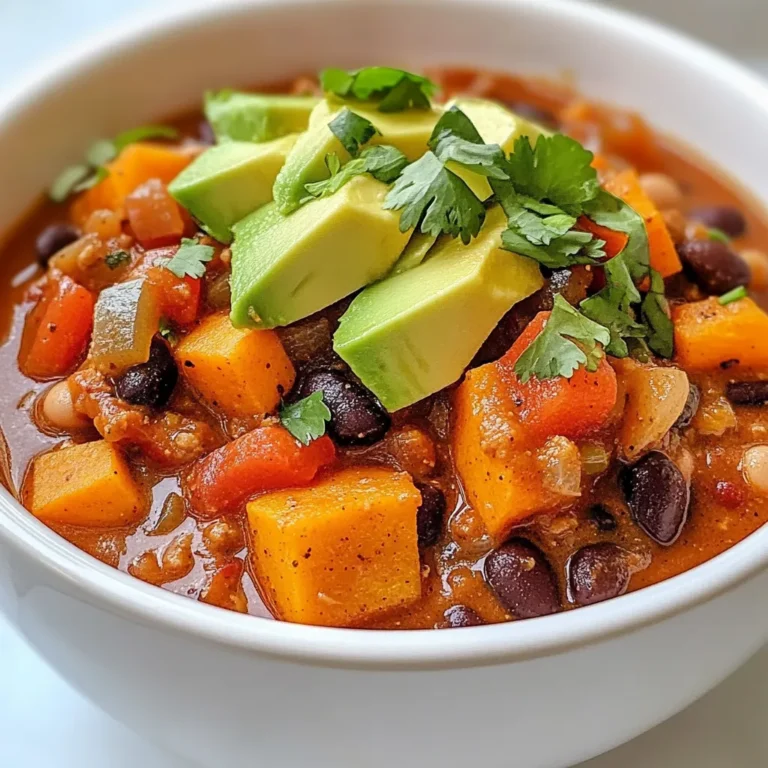
![To make tasty roasted veggie grain bowls, gather these items: - 1 cup quinoa, thoroughly rinsed - 2 cups vegetable broth - 1 zucchini, diced into bite-sized pieces - 1 red bell pepper, diced - 1 cup cherry tomatoes, halved - 1 cup broccoli florets, cut into small pieces - 2 tablespoons olive oil - 1 teaspoon garlic powder - 1 teaspoon smoked paprika - Salt and freshly cracked black pepper, to taste - 1 avocado, halved and sliced - ¼ cup tahini - 2 tablespoons freshly squeezed lemon juice - Fresh herbs (such as parsley or cilantro) for garnish Fresh ingredients make a big difference. Choose bright, firm veggies for the best flavor. Here are some tips to ensure freshness: - Look for vibrant colors: Fresh veggies should be bright and appealing. - Check for firmness: Avoid soft or wrinkled produce. - Buy local when possible: Seasonal veggies taste better and last longer. You can swap some ingredients based on your taste or what you have. Here are easy swaps: - Quinoa: Use farro, rice, or barley instead. - Veggies: Try carrots, asparagus, or sweet potatoes. - Tahini: Substitute with yogurt or nut butter for a different sauce. - Herbs: Use basil, dill, or chives for fresh flavor. Explore these options to make your roasted veggie grain bowls unique! For the complete recipe, check the Full Recipe. Start by preheating your oven to 425°F (220°C). This heat is perfect for roasting. While the oven warms, prepare the quinoa. In a medium saucepan, bring 2 cups of vegetable broth to a boil. Once boiling, add 1 cup of rinsed quinoa. Lower the heat, cover, and let it simmer for about 15 minutes. The quinoa will soak up the broth and become fluffy. After cooking, let it rest for 5 minutes. Fluff it with a fork before serving. While the quinoa cooks, prepare your veggies. Grab a large baking sheet and add the diced zucchini, red bell pepper, halved cherry tomatoes, and broccoli florets. Drizzle 2 tablespoons of olive oil over these veggies. Then, sprinkle 1 teaspoon of garlic powder, 1 teaspoon of smoked paprika, salt, and freshly cracked black pepper. Mix everything well to coat the veggies. Place the baking sheet in the oven and roast for 20-25 minutes. Halfway through, stir the veggies to ensure even cooking. They are done when tender and slightly caramelized. For the tahini sauce, combine ¼ cup of tahini and 2 tablespoons of freshly squeezed lemon juice in a small bowl. Whisk them together until smooth. Add a pinch of salt for flavor. If the sauce seems too thick, thin it out with a little water. Adjust it until you reach your desired consistency. You can check the [Full Recipe] for more details. When making roasted veggie grain bowls, avoid overcooking your vegetables. They should be tender but not mushy. Also, don't skip the seasoning. A little salt and pepper make a big difference. Lastly, ensure the quinoa is fluffed well after cooking. This helps the grains mix nicely with the veggies. To boost flavor, try marinating the veggies in olive oil and spices before roasting. You can add herbs like thyme or rosemary for a fresh taste. For texture, consider adding nuts or seeds. Toasted sunflower seeds or crunchy almonds add a nice bite. Roasted veggie grain bowls are great for a filling meal. Pair them with a side salad for more greens. You can also add a protein like grilled chicken or chickpeas for extra nutrition. For a wow factor, drizzle more tahini sauce on top or sprinkle with feta cheese. Check out the Full Recipe for more ideas! {{image_4}} You can switch up the grains in your bowl. Try brown rice, farro, or barley. Each grain brings a different taste and texture. Quinoa is great, but experimenting keeps it fun. You can also use millet for a unique twist. These grains offer more fiber and nutrients. Explore different cooking times for each grain to get them just right. Seasonal veggies make your grain bowl fresh and vibrant. In spring, use asparagus and peas. Summer calls for corn and eggplant. Fall brings sweet potatoes and kale. In winter, think about Brussels sprouts and root vegetables. Each season gives you new flavors and colors. Using fresh, local produce can boost taste and nutrition. Toppings can elevate your bowl. Consider adding nuts or seeds for crunch. Roasted chickpeas add protein and flavor. You might also try feta cheese for a salty kick. Fresh herbs like basil or cilantro can brighten the dish. A squeeze of lime or lemon juice adds freshness. For a spicy touch, drizzle hot sauce or sprinkle red pepper flakes. Each addition brings a new layer of flavor to your meal. Check out the Full Recipe for more ideas! To keep your roasted veggie grain bowls fresh, store them in airtight containers. Make sure to let the bowls cool down before sealing them. This helps prevent moisture buildup, which can make your veggies soggy. You can keep them in the fridge for up to four days. When you’re ready to enjoy your leftovers, reheat them gently. Use the microwave for quick heating. Heat in short bursts, stirring in between, to avoid hot spots. You can also warm them in a pan over low heat. Add a splash of water or broth to keep them moist. Meal prepping is a great way to save time. You can make extra quinoa and roast a variety of veggies. Store them separately in the fridge for easy access. This way, you can mix and match different flavors throughout the week. Just assemble the bowls when you're ready to eat. For a detailed recipe, check the Full Recipe for all the steps! Roasted veggie grain bowls are healthy meals filled with grains and vegetables. They combine cooked grains, like quinoa, with roasted veggies. This mix creates a tasty and colorful dish. You get fiber, vitamins, and minerals in every bite. The flavors blend well, making each bowl satisfying and fun to eat. To make roasted veggie grain bowls, follow these steps: 1. Preheat your oven to 425°F (220°C). 2. Cook 1 cup of quinoa in 2 cups of vegetable broth. Let it simmer until fluffy. 3. Prepare your veggies: dice zucchini, red bell pepper, and halve cherry tomatoes. Add broccoli florets. 4. Toss the veggies with olive oil, garlic powder, smoked paprika, salt, and pepper. 5. Roast the veggies for 20-25 minutes until tender and slightly caramelized. 6. Mix tahini with lemon juice, adding water if needed for the right texture. 7. Assemble the bowls with quinoa, roasted veggies, and avocado slices on top. 8. Drizzle with tahini sauce and add fresh herbs for garnish. You can find the full recipe above for more detailed steps. Yes, you can customize this recipe. Use different grains like brown rice or farro. Change the veggies based on what you like or what is in season. You can also add proteins like chickpeas or grilled chicken. Experiment with different sauces or toppings to make the dish your own. This flexibility makes roasted veggie grain bowls perfect for everyone. This blog covered how to make delicious roasted veggie grain bowls. We discussed key ingredients, focusing on freshness and substitutions. I shared step-by-step instructions for prepping, roasting, and creating a tasty tahini sauce. You learned helpful tips to avoid mistakes and enhance flavor. Variations allowed you to experiment with grains and veggies. Lastly, I provided storage tips to keep leftovers fresh. Roasted veggie grain bowls are flexible and fun. You can mix and match to fit your taste. Enjoy experimenting!](https://dishtreats.com/wp-content/uploads/2025/07/945baa8c-ba42-4ceb-8d11-39d9a326283a-768x768.webp)
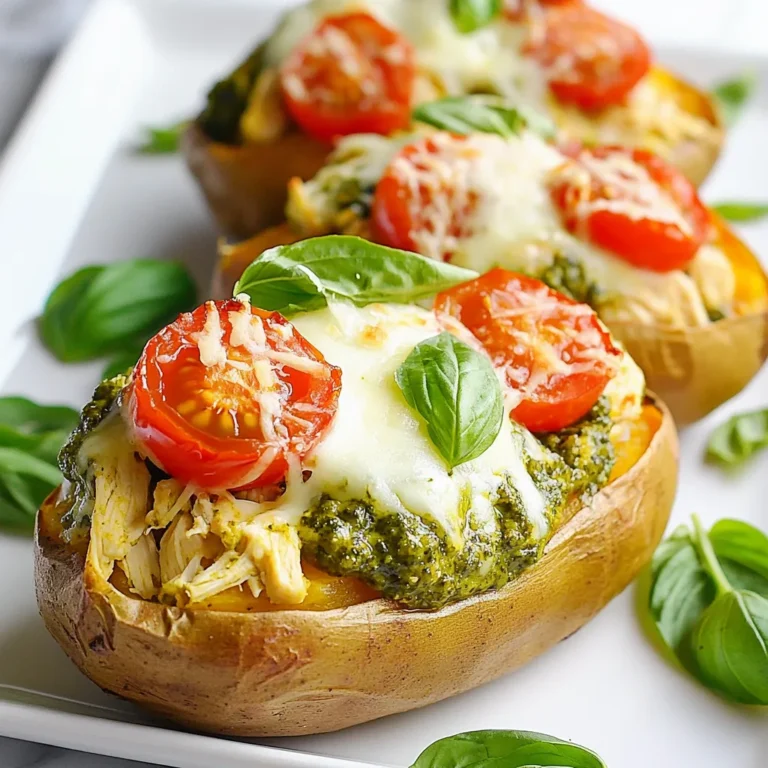
![To make a delicious Sweet Potato and Kale Hash, gather the following ingredients: - 2 medium sweet potatoes, peeled and diced into 1/2-inch cubes - 1 tablespoon extra virgin olive oil - 1 small onion, finely chopped - 2 cloves fresh garlic, minced - 1 bell pepper of your choice (red, green, or yellow), diced - 4 cups fresh kale, stems removed and leaves chopped - 1 teaspoon smoked paprika for a smoky flavor - 1/2 teaspoon ground cumin for warmth - Salt and freshly cracked pepper to taste - 2 large eggs (optional, for added protein) - Fresh parsley, chopped, for garnish These ingredients combine to create a hearty, flavorful dish. The sweet potatoes provide natural sweetness, while kale adds nutrition and color. The spices bring warmth and depth to the meal. If you choose to add eggs, they can make your hash more filling. This recipe celebrates whole, fresh foods that everyone will enjoy. For the full recipe, be sure to check out the detailed instructions! - Heating the oil: Start by placing a large skillet over medium heat. Add 1 tablespoon of extra virgin olive oil. Let the oil warm for about one minute. - Cooking sweet potatoes: Once the oil shimmers, add 2 medium sweet potatoes, peeled and diced into 1/2-inch cubes. Season them with salt and pepper. Sauté for 10-12 minutes. Stir occasionally until the sweet potatoes become tender and golden brown. - Sautéing onions and peppers: Next, add 1 small onion, finely chopped, and 1 bell pepper, diced. Cook for another 5 minutes. Stir often until the onion turns soft and translucent. - Adding aromatics: Stir in 2 cloves of minced garlic, 1 teaspoon of smoked paprika, and 1/2 teaspoon of ground cumin. Let this cook for 1-2 minutes. Stir frequently until the garlic smells fragrant and the spices blend well. - Incorporating kale: Add 4 cups of chopped kale to the skillet. Mix it well with the other ingredients. Cook for about 2-3 minutes until the kale wilts and softens. - Cooking eggs (optional): If you want to add protein, create small wells in the hash using the back of a spoon. Crack 2 large eggs into each well. Cover the skillet. Cook for 4-5 minutes, or until the egg whites are set but the yolks remain runny. - Finishing touches: Remove the skillet from heat. Taste the hash and adjust the seasoning with more salt and pepper if needed. Serve warm, garnished with fresh parsley. This dish is a wholesome meal in itself, packed with flavors and nutrients. For the full recipe, check out the detailed instructions above. - Ensuring even cooking for sweet potatoes Cut the sweet potatoes into even 1/2-inch cubes. This helps them cook at the same rate. When you sauté them, keep the heat at medium. Stir them occasionally to prevent sticking and promote browning. - Using fresh versus dried spices Fresh spices give a brighter taste. Try to use fresh garlic and smoked paprika for the best flavor. If you only have dried spices, use them but adjust the amount. Dried spices are stronger, so use less. - Best practices for sautéing kale Add the kale last, as it cooks quickly. Stir it in with the other ingredients for a couple of minutes. Cook until it wilts but remains bright green. This keeps the nutrients intact and enhances the dish's visual appeal. - Suggested pairings for the hash Serve the sweet potato and kale hash with toasted whole-grain bread. A slice of avocado on the side adds creaminess. You can also top it with salsa for a fresh kick. - Combining with proteins for a full meal Add eggs for protein. Cook them sunny-side up directly in the hash. You can also serve it with grilled chicken or turkey sausage for a hearty breakfast or brunch. For the complete recipe, check out the [Full Recipe]. {{image_4}} You can easily switch up the vegetables in this hash. Instead of sweet potatoes, try using: - Butternut squash for a sweeter taste. - Zucchini for a lighter option. - Mushrooms for added umami flavor. If you want a vegan dish, skip the eggs. You can still enjoy a hearty meal by adding: - Avocado for creaminess. - Tofu for protein. - Chickpeas for a filling option. The spices in this dish can change the whole flavor. You can adjust the seasoning to suit your taste: - Use curry powder for an Indian twist. - Try Italian herbs like oregano and basil for a Mediterranean flavor. If you like heat, you can add: - Red pepper flakes for a gentle kick. - Hot sauce for a bold flavor boost. These swaps keep your sweet potato and kale hash exciting and new each time! For the full recipe, check out the detailed instructions above. To keep your sweet potato and kale hash fresh, store it in an airtight container. This helps prevent moisture loss and keeps the flavors intact. The hash will stay good in the fridge for about 3 to 5 days. Make sure it cools down before sealing it. This way, it won’t steam inside the container. When it's time to reheat, you have a few good options. The best way is to use a skillet over medium heat. Add a touch of olive oil or water to keep it moist. Stir gently as it warms up. This method helps keep the texture just right. If you're in a hurry, you can use the microwave. Place the hash in a microwave-safe bowl. Cover it loosely with a paper towel to trap steam. Heat in short bursts, stirring in between, until warm. To refresh the dish, consider adding a squeeze of lemon or a sprinkle of fresh herbs. This adds brightness and makes the flavors pop again. Enjoy your meal! Yes, you can prepare this dish in advance. Cook the hash, let it cool, and store it in an airtight container. It will stay fresh in the fridge for up to three days. When you're ready to eat, just reheat it on the stove or in the microwave. Kale is a superfood packed with vitamins A, C, and K. It has lots of fiber, which helps digestion. Eating kale can boost your immune system and keep your bones strong. It also contains antioxidants, which help fight inflammation. To enhance the flavor of your hash, try adding different spices. A bit of chili powder can add heat. Fresh herbs like thyme or cilantro add freshness. You can also squeeze some lemon juice on top for a zesty kick. Consider using smoked salt for a deeper flavor. Absolutely! This hash works great for meal prep. You can make a big batch and separate it into containers. It’s easy to heat up for breakfast or lunch throughout the week. Plus, it tastes just as good reheated! For the full recipe, check out Savory Sweet Potato and Kale Hash. This blog post detailed how to create a tasty sweet potato and kale hash. I outlined the key ingredients and shared step-by-step cooking instructions. I also provided helpful tips and variations to fit your taste. In the end, this dish is simple and offers great nutrition. You can easily adjust it to suit your needs. Enjoy making this hash and feel free to get creative!](https://dishtreats.com/wp-content/uploads/2025/06/6b9629fe-c0a6-4f89-abcf-b289cc15d1fb-768x768.webp)
